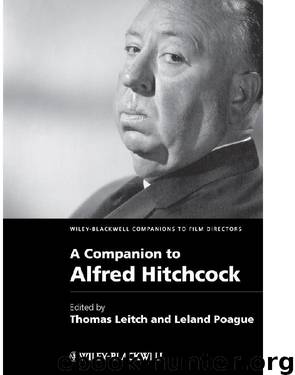A Companion to Alfred Hitchcock by Thomas Leitch & Leland Poague

Author:Thomas Leitch & Leland Poague
Language: eng
Format: epub
Publisher: John Wiley & Sons
Published: 2010-11-03T16:00:00+00:00
17
From Transatlantic to Warner Bros.
David Sterritt
According to the Producers Guild of America website, producers are powerful people who initiate, coordinate, supervise, and control all aspects of the motion-picture production process – creative, financial, technological, and administrative – on their own authority or that bestowed on them by studios or production companies. For movie directors and screenwriters, becoming a producer allows one, at least in theory, to preserve the artistic vision of a project by overseeing the creative and technical personnel who bring it to life. The list of major producer-directors during Hollywood’s studio era is impressive: D.W. Griffith, Charles Chaplin, John Ford, Ernst Lubitsch, Orson Welles, Howard Hawks, and many more. So it is not surprising that Alfred Hitchcock, whose meticulous preplanning and attention to detail are legendary, would want to become one too.
Hitchcock achieved this goal in the late 1940s, first by starting his own production company, Transatlantic Pictures, and then by acquiring a contract with Warner Bros. Pictures that allowed him to produce his films with unprecedented liberty in matters of material, writers, and cast. Curiously, however, Hitchcock’s greater independence did not immediately result in critically and commercially outstanding films. His first and only Transatlantic productions, Rope in 1948 and Under Capricorn in 1949, were bold in conception, unconventional in execution, and disappointing in box-office appeal. While his subsequent Warner Bros. projects were more successful, only Strangers on a Train (1951) could be called a full-blown hit; the other three – Stage Fright (1950), I Confess (1953), and Dial M for Murder (1954) – were profitable but not resoundingly so. Even so, the half-dozen years of Transatlantic and Warner Bros. productions were crucial ones in Hitchcock’s career, for this was when he acquired the skills that successful producer-directors always need, and needed with special urgency in the middle of the twentieth century, when Hollywood was moving from the classical studio era to a new age of modernism and innovation.
Shifting Currents
Using the conventional milestone of 1939 as the dividing point between Hitchcock’s vivacious British phase and the weightier American phase that began with Rebecca (1940), John Orr finds the latter period marked by the modulation of narrative suspense into psychodrama and by the recurring theme of bourgeois order being violated from within (11). The six Transatlantic and Warner Bros. pictures are grounded in precisely these concerns in ways that both confirm and complicate Orr’s account of Hitchcock as a “matrix-figure” in three senses – as a conjoiner of “cinephile authorship and … Hollywood genre” by means of preexisting stories modified to suit his purposes; as a creator standing “at the [authorial] centre of everything he filmed” as fully and commandingly as possible; and as a towering artistic force inhabiting the very “centre of cinema as such” (8–9, 10).
All of the films from Rope through Dial M for Murder are adapted from other works – three are based on novels, three on plays – and in most of them Hitchcock used his recently gained independence to amplify the existential tension and psychological suspense that audiences recognized as his trademarks.
Download
This site does not store any files on its server. We only index and link to content provided by other sites. Please contact the content providers to delete copyright contents if any and email us, we'll remove relevant links or contents immediately.
| Direction & Production | Reference |
The Kite Runner by Khaled Hosseini(5087)
Gerald's Game by Stephen King(4584)
Dialogue by Robert McKee(4326)
The Perils of Being Moderately Famous by Soha Ali Khan(4171)
The 101 Dalmatians by Dodie Smith(3455)
Story: Substance, Structure, Style and the Principles of Screenwriting by Robert McKee(3399)
The Pixar Touch by David A. Price(3369)
Confessions of a Video Vixen by Karrine Steffans(3247)
How Music Works by David Byrne(3191)
Fantastic Beasts: The Crimes of Grindelwald by J. K. Rowling(2996)
Harry Potter 4 - Harry Potter and The Goblet of Fire by J.K.Rowling(2993)
Slugfest by Reed Tucker(2945)
The Mental Game of Writing: How to Overcome Obstacles, Stay Creative and Productive, and Free Your Mind for Success by James Scott Bell(2847)
4 - Harry Potter and the Goblet of Fire by J.K. Rowling(2657)
Screenplay: The Foundations of Screenwriting by Syd Field(2576)
The Complete H. P. Lovecraft Reader by H.P. Lovecraft(2514)
Scandals of Classic Hollywood: Sex, Deviance, and Drama from the Golden Age of American Cinema by Anne Helen Petersen(2467)
Wildflower by Drew Barrymore(2445)
Robin by Dave Itzkoff(2387)
